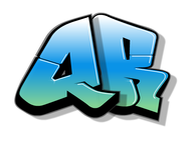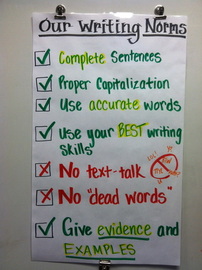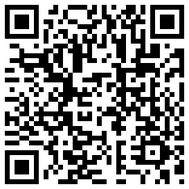|
“Let’s Give ‘Em Something to Talk About” The art of classroom discussion is nebulous at best. Sometimes profound, other times a total loss in terms of student participation or the quality of input, whole-class discussions can make or break a lesson. In short, sometimes as a teacher you end up feeling like this guy: For one of my current classes, finding meaningful contributions to make during discussion can be challenging. The majority of the class is comprised of students who have a long history of testing below grade level. (While I’m not a fan of high-stakes multiple choice testing, I do believe it provides some insight about a student’s level of proficiency.) Many of the kids are also reluctant readers and writers, so they struggle in multiple areas. What’s been really great to watch, however, is how they come alive whenever they are able to use technology. Using iPods and iPads has become a great motivator for these students, who might otherwise remain locked out of proficiency. Since whole class discussion has proven to be somewhat of a nemesis for them, I decided to utilize a few of my favorite electronic discussion tools to see how I could encourage and inspire them to share their thoughts. “Hey, I Just Met You. And Call Me Crazy, But Here’s My Number – So, Meet Me, Maybe?” The first tool I chose to use today with my kiddos was the Web 2.0 tool called Today’s Meet. I created a room for my students to join using iPod Touches, then posed discussion questions to them. Their task was to share their opinion, then offer at least one quality response to another person’s opinion. I modeled an appropriate response to a sample question and also modeled what a meaningful response would look like. I scaffolded quality by reminding students about our writing norms. (See below.) As students used Today’s Meet, they were 100% engaged, 100% enthusiastic, and 100% eager to share. My classroom, which is hardly ever silent on purpose, was quiet enough to hear a pin drop. While my usually noisy, learning-filled room makes me happy, I found that I equally enjoyed the silent, sharing-filled room as students actively responded to discussion prompts. Furthermore, the responses they gave each other made quite an impact, too. Students who normally tend to withdraw during whole-class activities, and even sometimes in small group ones, were some of the fastest typists because they had so much to say and felt comfortable in the electronic discussion medium. Here’s some video I captured with iPhone of the kids using Today’s Meet: And, just in case you’d like to view my video tutorial on how to use today’s meet, click HERE. “Well, I Feel Like They’re Talking in a Language I Don’t Speak” After using Today’s Meet, I had my kids use an app called Socrative on their iPods. Socrative is a virtual questioning environment, but instead of talking to one another, the students were talking to me. I went onto the Socrative website and quickly created a Quick Quiz that the students used to provide share their thoughts on our reading today. My quiz consisted of 6 short response questions and students had a blast responding using the Socrative Student app on the iPods. While in any other class it would be a struggle to get kids to answer comprehension and analysis questions on paper without groaning, my students were excited to be able to answer questions and share their thoughts using an app. Ultimately, our students are digital natives and technology is the language they speak. If we want to engage kids, we need to meet them on their own turf, not force them to "speak the language" of traditional academia. Here is another video clip of my students. This time, they’re using Socrative: A Cautionary Word About Technology Use in the Classroom This morning I read a really great infographic made by Mark Bates (found here) based on a blog post written onAlwaysPrepped entitled, “7 Habits of Highly Effective Teachers Who Use Technology.” The author identifies the first habit as only using technology with justification in mind for why it’s being used. The blog post states that, “Highly effective teachers who use technology always have a reason for using new technology tools.” I think this is very true. Students can unequivocally tell when a task is “busy work” or an authentic experience that is intended to help them learn. There should certainly be a well-thought out purpose behind every activity and the tools you give students to complete it. Would you give students a knife to cut paper? Of course not! Although it’s sharp, it’s not the most appropriate method of cutting paper. When planning lessons, we need to view all of our technology implementation ideas through an editing lens to decide whether or not using it would be best practice. Finally, before signing off, I thought I’d share some screen caps from the conversation my students had in Today’s Meet: Be brave, fellow teachers in the trenches! I know I just met you, and this is crazy, but use Meet with your students, maybe? If you have any questions about how to integrate Today's Meet, Socrative, or iOS devices, please comment on this post.
0 Comments
 Another school year is about to begin in Palm Springs Unified, and we've spent the past two days enjoying various forms of staff development. This morning at our district kick-off, it was revealed that our district has decided to implement a Bring Your Own Device (BYOD) network that will be made accessible to teachers and students. Our reaction? Finally! With the impending advent of an open network and the sudden ability to increase the amount of technology in our classrooms, one of the first practical uses of BYOD is being able to use QR codes and with greater frequency and effectiveness. So, let's talk about QR codes and I'll take this opportunity to also practice my colloquial middle schooler speech in preparation for the first day of school... Download THIS If You're a Baller A "baller" is defined in the urban dictionary as "a thug that has 'made it' to the big time," and around these parts you're a baller if you've got an iPad, iPod Touch, or iPhone. Any of those fantastic iOS devices can be used to scan QR codes. What is a QR code, you might ask? For those who need to know, QR is short for Quick Response and it's essentially a type of bar code that can be scanned by a tablet or smartphone. What do you get when you scan? Easy. You get whatever the person who generated the code wants you to get: a piece of text, a link to a website, a voice note, etc. Now, what I absolutely LOVE about QR codes is the price, because it's easy to swallow: FREE. There are a ton of free QR scanners and QR generators for you to download for your iPad or other iOS device. The absolute best thing about QR codes is that they are so easy to use, even the most tech-challenged teacher can manage it. After downloading and testing out several QR scanners and generators, here are the ones I like the best: Some Sweet Ways to Integrate QR in Your 'Hood My first classroom consideration when the BYOD network rolls out will be the need to establish classroom norms for technology use. Historically, my school site has had a "No Cell Phones" policy that involved confiscating students' cell phones if they were seen or heard in class. I'm excited for the chance to be able to further embrace the digital nature of my students and plan to explicitly teach them about the appropriate and academic use of their own devices within my classroom walls. Since there is the potential for a lot more off-task temptation with personal devices as opposed to school devices, an effective introductory activity could be generating a series of QR codes that delineate the acceptable use of personal technology (in kid-friendly language) piece by piece in a short bit of text. For some fun and variety, a few entertaining video clips or an audio-note could be thrown into the mix, too. Students could move around the room on a QR Hunt to find and scan each code. Students who don't have smart phones could simply pair up with ones who do. (It is worth noting that most of my students do have smartphones and since QR code scanners are Android friendly - no problem.) Here are a few other ways you and your students could rock the whole QR thing:
BYOD = No More "IDK"
Probably the most exciting aspect of having a BYOD network is being able to eliminate the oft-used and well-loved (or not) middle school excuse: "I don't know." Whether they're trying to be cool or just feeling painfully awkward, this phrase can sometimes become the typical middle schooler's default. The incredible thing about enabling personal devices in the classroom is that it gives students a chance to take their inner digital native and turn him (or her) into a Lean, Mean, Informationally Literate Machine! Purposeful, explicit instruction in how to effectively search for information, synthesize multiple sources, and evaluate credibility is necessary. Obviously, the more exposure to technology and the more we demonstrate how it can be used effectively in an academic setting, the more prepared for college and career our students will become. QR codes serve as a pretty effective vehicle for that kind of 21st century learning. And now, since you've read this whole post and you're about to return to the "thug life" you put on hold about five minutes ago, here is a QR code I generated just for you. This is what I tell kids on the first day of school: |
Author: Jessica PackCalifornia Teacher of the Year. CUE Outstanding Educator 2015. DIGICOM Learning Teacher Consultant. 6th Grade Teacher. Passionate about gamification, Minecraft, digital story-telling, and fostering student voices. Download:Archives
June 2020
Categories
All
|





 RSS Feed
RSS Feed